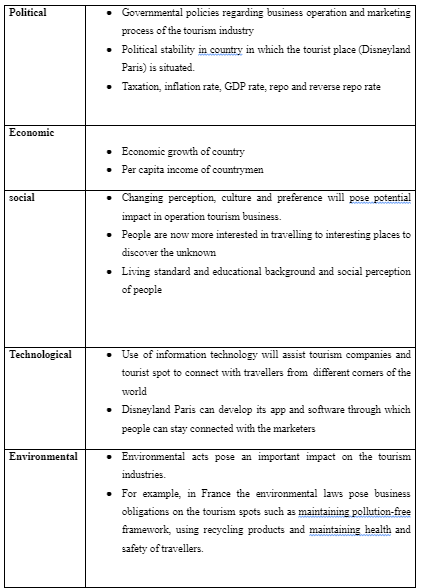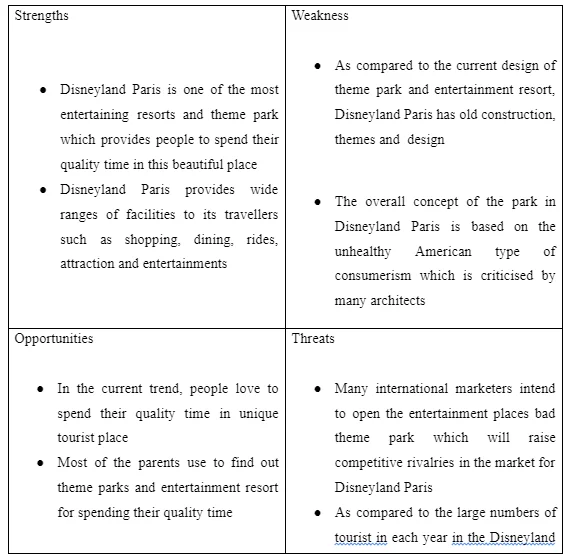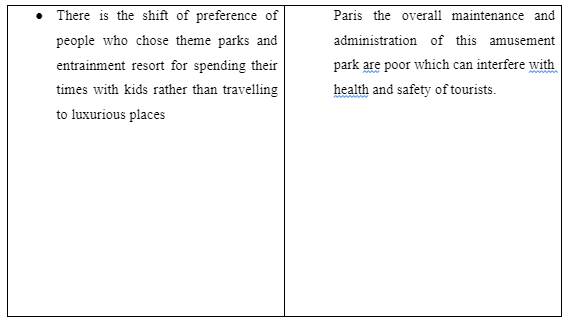Strategic Marketing and Analysis of Disneyland Paris in the Booming Tourism Industry
Executive summary
The tourism industry has gained optimum financial and social benefits in the current market situation. In today's business world tourism industry has grabbed high economic growth and marketing success due to an increasing number of travel lovers in the world. Through using the PESTEL and SWOT analysis, marketers of tourism Company can analyse the impact of internal and external environment on their overall business decision and marketing operation. By seeking marketing dissertation help, professionals can enhance their understanding of these analyses. Through using the marketing mix, it is possible to analyse how the tourism business will set its overall business strategies to grab competitive advantages. Finally, it can be stated that, as there are fewer market players in the market this will bring new opportunities for the marketers to grab customer attention through maintaining highly systematic marketing operations. This study will also discuss the market segmentation and target market of Disneyland Paris in term of depicting the marketing agendas and current market strategies of Disneyland Paris. This study is going to discuss the Porter Five forces in the tourism industry to analyse the overall competitive environment of the given tourist spot, Disneyland Paris. In addition to this, this study will also do the SWOT analysis in the tourism industry in term of determining the strength and weakness of Disneyland Paris. Finally, this assignment is going to highlight the strategies that Disneyland Paris is going to set in terms of representing its uniqueness to convince travellers to choose this place over the competitors.
Introduction:
In today’s business world, tourism industry has grabbed high economic growth and marketing success due to increasing number of travel lovers in the world. This study is going to discuss the Porter Five forces, PESTEL and SWOT in tourism industry to analyse the overall competitive environment of the given tourist spot, Disneyland Paris. This study will also discuss the market segmentation and target market of Disneyland Paris in term of depicting its marketing agendas and current market strategies. Finally, this assignment is going to highlight the strategies that Disneyland Paris is going to set in terms of representing its uniqueness to convince travellers to choose this place over the competitors.

Porter’s five forces model of tourism industry;
Competitive rivalries:
According to Dileep and Mathew (2017), rivalries for tourist spot and theme park is relatively its needs huge capital, high maintenance cost and strong administration. In this context, as Disneyland Paris is the theme park, it will face relatively low competition from the rivals in the same market. If there are few numbers of tourist places and theme park in the country as compared to huge number of customers then it is beneficial for the tourist spots as they have strong chances of grabbing potential customers. In this context, Disneyland Paris needs to decorate and design the theme park in modern pattern which will attract customers. Moreover, although there is low competition for Disneyland Paris in the market, there are some rivalries threats of overseas tourist spots such as Sea World park-USA and Genting Disneyland Paris and Highlands-Malaysia.
Threats of Substitute:
According to Paliokas et al. (2019) substitutes are the similar products and services that are offered by a similar or different brand and serve the same purpose. In tourism industry, the number of players is relatively less than the other industries. This will provide opportunity for Disneyland Paris to improve its customer base by offering high quality as well as convenient service to travellers which will assist the travellers to select this theme park over the other tourist spot.
Bargaining power of suppliers:
As number of tourist’s spots and theme park is less in the number, the numbers of suppliers are also less in the tourism industry as they have few companies to deliver raw materials (Borden et al. 2017). In this context, Disneyland Paris can face high bargaining power of single suppliers as the suppliers can charge high rate of raw materials. For reducing the rates of raw materials, Disneyland Paris needs to improve its overall marketing strategies and manages the process which will assist marketers to bargain the price of products with the suppliers to get the raw material at reasonable prices.
Continue your exploration of Global and Cross Cultural Marketing with our related content.
Bargaining power of buyers:
Due to less number of theme parks and tourist spot in the tourism industry, the bargaining power buyers (actual travellers) is low as they have very limited options to choose the best tourist spot (Font and McCabe, 2017). In this context, Disneyland Paris needs to impress the travellers by launching new themes which will attract kids, young and middle people to choose thus theme park over the other travel destinations.
Threats of new entrants:
As there are few players in the tourism market, threats of new entrants are relatively high which will pose a negative impact on business success and marketing operation of Disneyland Paris. As there are very few theme parks and travel destination in the market compared to the other industries, the intensity of market competition is relativity low (Morrison, 2018). On the other hand, number of travel-lovers in every year across the world. This situation encourages many potential overseas brands in the international market to enter into tourism industry to grab the ultimate market success. Therefore, Disneyland Paris can face high competition threats of new entrants.
PESTEL analysis in the tourism industry:


SWOT analysis of Disneyland Paris:


Market segmentation of the Disneyland Paris:
According to Jatav and Mittal (2017), market segmentation is the process of dividing the entire heterogeneous market into different segments. Market segmentation is of four types such as demographic, geographic, psychographic and behavioural.
Geographic market segmentation:
In case of geographic market segmentation, Disneyland Paris has focused on the urban and semi-urban areas in France and other international countries. On the other hand, Disneyland Paris has opened its resort and theme park in the areas in which there is smooth transport service, crowded place and metro city area of France.
Demographic market segmentation:
In demographic market segmentation, Disneyland Paris has focused on the following aspects:
Age group: people within the age group 10-45 years
Gender: kids, men and women
Education: Parent with minimum 10 + degree, as it is necessary for understanding that which ride will be appropriate for the kids and which are not.
Psychographic market segmentation:
Lifestyle: Disneyland Paris target people with high and middle standard lifestyles, which is important for affording to cost of tickets and rides in this theme park
Personality: Fun-loving people who love to travel into the amusement parks and theme park are targeted by Disneyland Paris.
Behavioural segmentation:
User’s rate: Travel-loving people who use to chose theme parks and entertainment parks in each year or their kids
User status: highly enthusiastic, motivating and fun-loving people who are ready to invest into theme parks and amusement places to spend quality time with the family
The target market of Disneyland Paris
Disneyland Paris has targeted people within the age group 10-45 who will, able to enjoy the rides and games with their family members. According to Matikiti et al. (2018), target market is important for any business in which the markets needs to focus on the proper criteria which will assist them to chose the right client to enhance the or overall market profit. The marketers of Disneyland Paris has targeted people in the crowded places and urban areas such as metro city, malls, schools, and colleges campus, in which the marketers are going to show off their online promotional ads through the over-head projectors on streets.
How Disneyland Paris can differentiate itself from direct and indirect marketers:
Disneyland Paris can differentiate itself from the direct and indirect marketers through launching new rides in the theme park which will attract the parent and kids to spend their quality time in this Entertainment Park and resort. In addition to this, the marketers of Disneyland Paris can offers discount in shopping and rid s for kids and disabled people which will assist marketers to convince its clients to invest into this park over the others. Marketers of Disneyland Paris can also arrange some fun games and science fiction shows which will be highly attracted things for kids in this park. Finally, marketers of Disneyland Paris needs to make innovative marketing strategies such as providing online messages to parents and young people in terms of representing the uniqueness id thus park.
How Disneyland Paris can get a unique position in the tourism industry:
Disneyland Paris can get a unique position in the tourism industry by enhancing its brand reputation through maintaining a trustworthy relationship with the tourists. Through developing a high level of corporate social responsibility, to make proper social, financial and cultural development in the society, Disneyland Paris can get unique position in the internal market. In addition to that, through systematically decorating the park and resort with launching new as well as attractive rides in the park, Disneyland Paris can be one of the most lovable and preferable places for tourist in France as well as in the international place which will also assist the marketers to get unique position in the industry.
Discuss marketing mix of Disneyland Paris:
Price:
Marketers of Disneyland Paris have set reasonable rice for each ride and shows which will assist marketers to grab huge customer support
Product:
Disneyland Paris prioritises the quality of its products such as all machines, instruments and riding accessories for assuring the health and safety for customers. In addition to this, marketers if Disneyland Paris also focuses ensuring the quality of its services such as enjoyable riding, amazing kid shows and proper administration which represent the high level of market reputation in the domestic as well as in the international tourism industry.
Place:
Marketers and administrator of Disneyland Paris maintain systematic receive the supply of instrument and raw materials from dealers and suppliers. In this context, marketers have maintained healthy and strong relationships with the suppliers and dealers in terms of receiving high quality riding parts which will ensure the safe ride for customers.
Promotion:
Through using online advertisements in official websites, famous blogs and YouTube, Disneyland Paris is going to put more focus on maintaining the unique position of this park in addition to this Disneyland Paris is going to conduct online promotional shows which will assist this park to grab the attention of young generations and kids.
How Disneyland Paris with create communicate and deliver the value to its customers in the tourism market:
Through maintaining decent and polite interaction with the customer, Disneyland Paris can provide proper respect and dignity to them. In addition to this, marketers and staffs of Disneyland Paris will maintain trustworthy and loyal relationship with customers by valuing their decisions, preference and interest. According to Nqosa et al. (2019), marketers can value their customer by listening to their issues and respect their decision and interests. In this context, Disneyland Paris will review the experience of customers in this place for making effective changes in their hospitality and marketing process which will assist markets to provide convenient service.

Conclusion:
From the above-mentioned discussion, it can be concluded that tourism industry has gained optimum financial and social benefits in current market situation. Through using the PESTEL and SWOT analysis, marketers of tourism Company can analyse the impact of internal and external environment on their overall business decision and marketing operation. Through using the marketing mix, it is possible to analyse how the tourism business will set its overall business strategies to grab competitive advantages. Finally, it can be stated that, as there are fewer market players in the market this will bring new opportunities for the marketers to grab customer attention through maintaining highly systematic marketing operations.
Recommendation:
- Disneyland Paris should focus on conducting innovative promotion and marketing strategies of this park which will assist marketers to grab high-level of competitive advantages
- Marketer’s ad administrator of Disneyland Paris will focus on maintaining proper health and safety of customers
- Marketers of Disneyland Paris should invest into launching of innovative rides and games in this park which attract of kids and parent to choose this destination over the others.
Reference list:
- Borden, D.S., Coles, T. and Shaw, G., 2017. Social marketing, sustainable tourism, and small/medium size tourism enterprises: challenges and opportunities for changing guest behaviour. Journal of Sustainable Tourism, 25(7), pp.903-920.
- Dileep, M.R. and Mathew, V., 2017. Marketing of Tourism Industry: Enhancing Services through Marketing Mix Elements. In Strategic Marketing Management and Tactics in the Service Industry (pp. 304-329). IGI Global.
- Font, X. and McCabe, S., 2017. Sustainability and marketing in tourism: Its contexts, paradoxes, approaches, challenges and potential. Journal of Sustainable Tourism, 25(7), pp.869-883.
- Fordred, C.L. and Mearns, K., 2018. Resilience thinking used as a sustainable tourism marketing tool for protected areas. Marketing Sustainable Tourism Products, p.64.
- Fyall, A., Legohérel, P., Frochot, I. and Wang, Y., 2019. Marketing for Tourism and Hospitality: Collaboration, Technology and Experiences. Routledge.
- Gupta, G., 2019. Inclusive use of digital marketing in tourism industry. In Information Systems Design and Intelligent Applications (pp. 411-419). Springer, Singapore.
- Hosie, P. and Pforr, C., 2016. Crisis and post-crisis tourism destination recovery marketing strategies. In Crisis Management in the Tourism Industry (pp. 225-242). Routledge.
- Jatav, S. and Mittal, A., 2017. The Role of Service Marketing in India with Reference to the Tourism Industry. In Tourism Marketing (pp. 81-94). Apple Academic Press.
- John, S., Larke, R. and Kilgour, M., 2018. Applications of social media for medical tourism marketing: an empirical analysis. Anatolia, 29(4), pp.553-565.
- Kaur, G., 2017. The importance of digital marketing in the tourism industry. International Journal of Research-Granthaalayah, 5(6), p.72.
- Litvin, S.W., Goldsmith, R.E. and Pan, B., 2018. A retrospective view of electronic word-of-mouth in hospitality and tourism management. International Journal of Contemporary Hospitality Management.
- Makkonen, T., 2016. Cross-border shopping and tourism destination marketing: the case of Southern Jutland, Denmark. Scandinavian journal of hospitality and tourism, 16(sup1), pp.36-50.
- Matikiti, R., Mpinganjira, M. and Roberts-Lombard, M., 2018. Application of the technology acceptance model and the technology-organisation-environment model to examine social media marketing use in the South African tourism industry. South African Journal of Information Management, 20(1), pp.1-12.
- Morrison, A.M., 2018. Marketing and managing tourism destinations. Routledge.
- Nqosa, N.E., Burger, S.E. and Lekaota, L., 2019. Identifying the key success factors for marketing tourism establishments: a case study of four regions in Lesotho.
- Paliokas, I., Sylaiou, S., Katertsidis, N., Tsakai, O., Tzallas, A., Giannakeas, N., Tsipouras, M., Votis, K. and Nomikos, V., 2019. OneAppy: An Interactive Platform Providing Novel Marketing Channels and Promoting Product and Services to the Tourism Industry. In Strategic Innovative Marketing and Tourism (pp. 559-568). Springer, Cham.
- Séraphin, H., Ambaye, M., Gowreesunkar, V. and Bonnardel, V., 2016. A marketing research tool for destination marketing organizations' logo design. Journal of Business Research, 69(11), pp.5022-5027.
- Todua, N., 2018. Impact of social media marketing on consumer behavior in the Georgian tourism industry. International Academy Journal Web of Scholar, 3(5 (23)), pp.11-16.
- Üzümcü, T.P., Günsel, A. and Yavaş, A., 2017. The consequences of internal marketing activities on emotional labor in tourism industry. Journal of Human Sciences, 14(2), pp.1909-1923.
Looking for further insights on Strategic Marketing Analysis of Samsung? Click here.
- 24/7 Customer Support
- 100% Customer Satisfaction
- No Privacy Violation
- Quick Services
- Subject Experts



